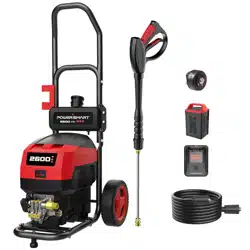Loading ...
Loading ...
Loading ...

7
Always wear eye protection with side shields marked to comply with ANSI Z87.1, along with
hearing protection. Failure to do so could result in objects being thrown into your eyes and other
possible serious injuries.
Keep battery pack dry, clean, and free from oil and grease. Always use a clean cloth when cleaning.
Never use brake fluids, gasoline, petroleum-based products, or any solvents to clean battery pack.
Do not open or mutilate the battery. Released electrolyte is corrosive and may cause damage to the
eyes or skin. It may be toxic if swallowed.
WARNING: Read all safety warnings and instructions. Failure to follow the warnings and
instructions may result in electric shock, fire and/or serious injury.
a) Prevent unintentional starting. Ensure the switch is in the off-position before connecting to battery
pack, picking up or carrying the appliance. Carrying the appliance with your finger on the switch or
energizing appliance that have the switch on invites accidents.
b) Disconnect the battery pack from the appliance before making any adjustments, changing accessories,
or storing appliance. Such preventive safety measures reduce the risk of starting the appliance
accidentally.
c) Recharge only with the charger specified by the manufacturer. A charger that is suitable for one type of
battery pack may create a risk of fire when used with another battery pack.
d) Use appliances only with specifically designated battery packs. Use of any other battery packs may
create a risk of injury and fire.
e) When battery pack is not in use, keep it away from other metal objects, like paper clips, coins, keys,
nails, screws or other small metal objects, that can make a connection from one terminal to another.
Shorting the battery terminals together may cause burns or a fire.
f) Under abusive conditions, liquid may be ejected from the battery; avoid contact. If contact accidentally
occurs, flush with water. If liquid contacts eyes, additionally seek medical help. Liquid ejected from the
battery may cause irritation or burns. (This advice is considered correct for conventional NiMh, NiCd,
lead acid and lithium-ion cell types. If this advice is incorrect for a cell design that differs from these, then
the correct advice may be substituted.)
g) Do not use a battery pack or appliance that is damaged or modified. Damaged or modified batteries
may exhibit unpredictable behavior resulting in fire, explosion or risk of injury.
h) Do not expose a battery pack or appliance to fire or excessive temperature. Exposure to fire or
temperature above 130°C may cause explosion. The temperature of 130°C can be replaced by the
temperature of 265°F.
i) Follow all charging instructions and do not charge the battery pack or appliance outside of the
temperature range specified in the instructions. Charging improperly or at temperatures outside of the
specified range may damage the battery and increase the risk of fire.
j) Have servicing performed by a qualified repair person using only identical replacement parts. This will
ensure that the safety of the product is maintained.
k) Do not modify or attempt to repair the appliance or the battery pack (as applicable) except as indicated
in the instructions for use and care.
Proper care for battery
Off-season storage
To obtain the longest possible battery life, we suggest the following:
Remove the battery pack from the charger once it is fully charged and ready for use.
For battery pack storage longer than 30 days:
Store the battery pack where the temperature is below 80°F and away from moisture.
Store battery packs in a fully charged condition.
Every two months of storage, charge the pack as normal.
Loading ...
Loading ...
Loading ...
